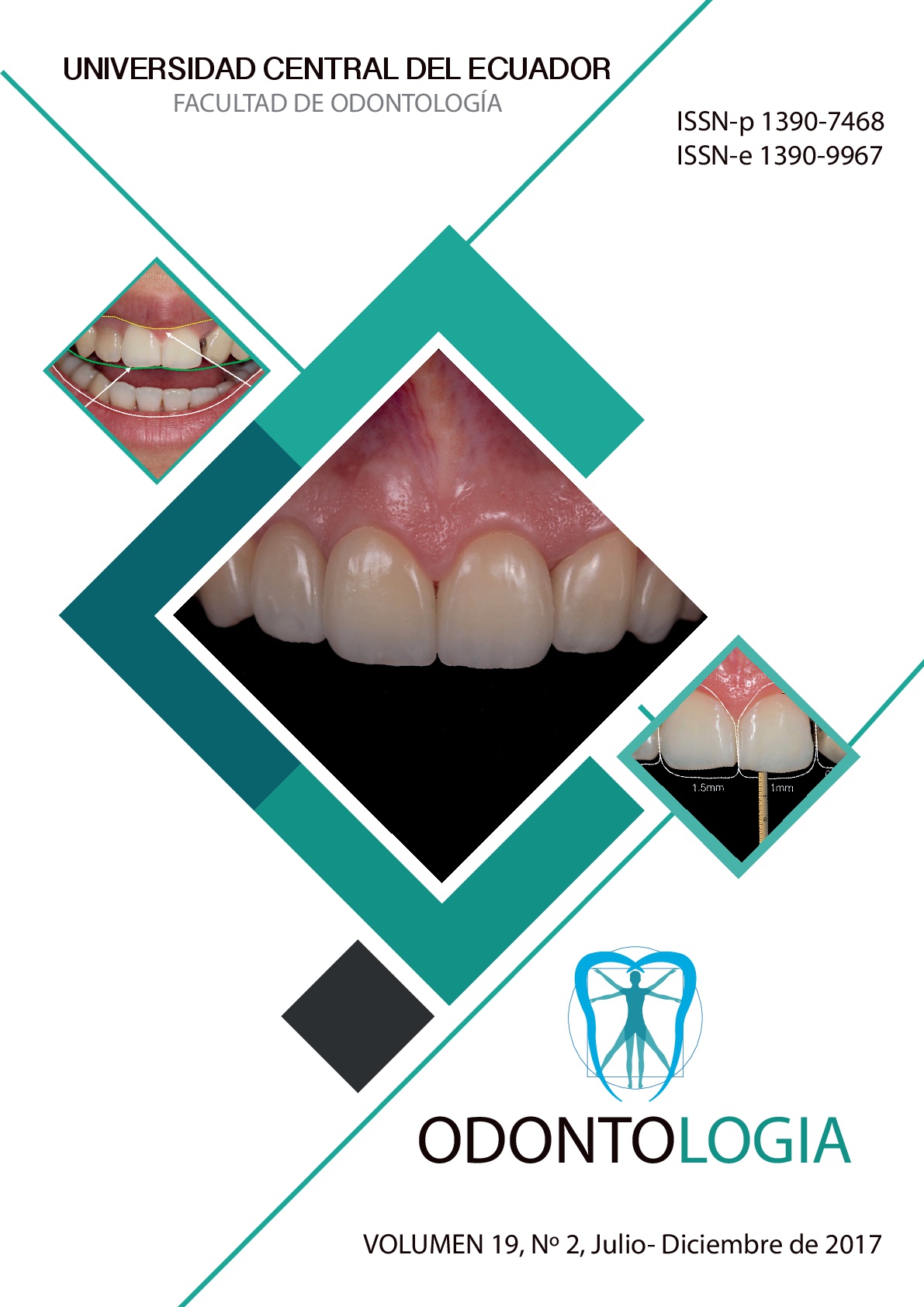Evaluation of the microhardness of enamel affected by incipient caries and treated by two types of fluoride varnishes: In vitro study
DOI:
https://doi.org/10.29166/odontología.vol19.n2.40-52Keywords:
Permanent dentition, dental caries, fluorine, dental enamelAbstract
Fluoride has shown its effectiveness in the therapy of initial lesions of caries. Currently, there are new fluoride varnishes with additional remineralizing agents, to treat lesions of non-cavitated caries in a non-invasive way, promoting the remineralization of the enamel. Objective: To determine the microhardness of enamel with incipient caries lesions treated with two fluoride varnishes. Materials and methods: In vitro experimental study. The sample consisted of 35 enamel blocks, which were randomly divided into 3 groups. G1 (n=5): negative control; G2 (n=15): Fluorine varnish (Flúor protector - Ivoclar Vivadent) and G3 (n=15): Fluorine varnish with Tricalcium Phosphate (Clinpro White Varnish - 3M ESPE). Three indentations were made by means of a microhardness meter, in order to obtain the initial hardness, then the samples were demineralized with the purpose of producing incipient lesions, where 3 indentations were made again to obtain the microhardness of the demineralized enamel, after this phase the remineralizing solution in each sample and a cyclical pH regime was followed during 7 days to simulate the oral conditions, after this period 3 indentations were made in each sample to obtain the final hardness of the remineralized enamel, reaching a total of 9 indentations per sample. The data were analyzed using the Scheffé test and the Student’s T test with a level of significance of 5%. Results: There was a significant difference between the fluoride varnish with Tricalcium Phosphate (TCP) and the control group (p=0.03). No significant differences were found between the different fluorinated varnishes (p=0.09). A significant improvement of the microhardness after treatment of both fluoride varnishes was observed (p<0.001). Conclusion: The two types of fluoride varnishes efficiently increased the microhardness of enamel with incipient caries lesion, without significant difference between these two.
Downloads
References
Prasad K, Madhu P, Namrata H, Viraj Y, Kavita T, Maya K. Preventive techniques & remineralization of dental caries for Public Health: A review. Indian Jornal of Dental Science. 2013; 5(5): 105-10.
Cedillo VJJ. Uso de los derivados de la caseína en los procedimientos de remineralización. Rev ADM. 2012; 69(4): 191-99.
Cuadrado VDB, Peña CRE, Gómez CJF. El concepto de caries: hacia un tratamiento no invasivo. Rev ADM. 2013; 70(2): 54-60.
Jefferies SR. Advances in remineralization for early carious lesions: a comprehensive review. Compend Contin Educ Dent. 2014; 35(4): 237-43.
Nuñez DP, Bacallao LG. Bioquímica de la caries dental. Rev haban cienc méd. 2010; 9(2): 156-66.
Gutierrez B, Planellis P. Actualización en odontología mínimamente invasiva: remineralización e infiltración de lesiones incipientes de caries. Cient Dent 2010; 7(3): 183-91.
Frencken JE, Peters MC, Manton DJ, Leal SC, Gordan W, Eden E. Minimal intervention dentistry for managing dental caries – a review: report of a FDI task group. Int Dent J. 2012; 62(5): 223-43.
Castellanos JE, Marín LM, Úsuga MV, Castiblanco GA, Martignon S. La remineralización del esmalte bajo el entendimiento actual de la caries dental. Univ Odontol. 2013; 32(69): 49-59.
Argenta RMO, Tabchoury CPM, Cury JA. A modified pH-cycling model to evaluate fluoride effect on enamel demineralization. Pesqui Odontol Bras. 2003; 17(3): 241-6.
Queiroz CS, Hara AT, Leme AFP, Cury JA. pH-cycling models to evaluate the effect of low fluoride dentrifice on enamel de -and remineralization. Braz Dent J. 2008; 19(1): 21-7.
Portilla JR, Pinzón MT, Huerta EL, Obregón AP. Conceptos actuales e investigaciones futuras en el tratamiento de la caries dental y control de la placa bacteriana. Revista Odontológica Mexicana. 2010; 14(4): 218-25.
Badet C, Richard B. Étude Clinique de la carie. EMC Dentisterie. 2004. 1: 40-8.
Karlinsey RL, Mackey AC, Dodge LE, Schwandt CS. Noncontact remineralization of incipiente lesions treated with a 5% sodium fluoride varnish in vitro. J Dent Child. 2014; 81(1): 7-13.
Stookey GK, Featherstone JD, Rapozo-Hilo M, Schemehom BR, Williams RA, Baker RA, Barker ML, Kaminski MA, McQueen CM, Amburgey JS, Casey K, Faller RV. The Featherstone laboratory pH cycling model: a prospective, multi-site validation exercise. Am J Dent. 2011; 24(5): 322-8.
Marinho VC, Worthington HV, Walsh T, Clarkson, JE. Fluoride varnishes for preventing dental caries in children and adolescents. Cochrane Database Syst Rev. 2013, 11(7): CD002279.
Karlinsey RL, Pfarrer AM. Fluoride plus functionalized B-TCP: a promising combination for robust remineralization. Adv Dent Res. 2012; 24(2): 48-52.
Elkassas D, Arafa A. Remineralizing efficacy of different calcium-phosphate and fluoride based delivery vehicles on artificial caries like enamel lesions. J Dent 2014; 42(4): 466-74.
Rirattanapong P, Vongsavan K, Saengsirinavin C, Pommahala T. Effect of fluoride varnishes containing tri-calcium phosphate sources on remineralization of initial primary enamel lesions. Southeast Asian J Trop Med Public Health. 2014; 45(2): 499-504.


